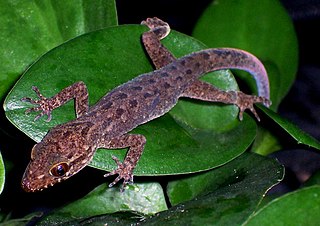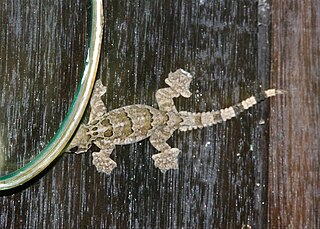
Gekko is a genus of Southeast Asian geckos, commonly known as true geckos or calling geckos, in the family Gekkonidae. Although species such as Gekko gecko are very widespread and common, some species in the same genus have a very small range and are considered rare or endangered.

Hemiphyllodactylus is a genus of geckos ranging from India and China southward to Southeast Asia and Oceania. Species of Hemiphyllodactylus are commonly known as half leaf-fingered geckos. Many species are known as dwarf geckos or slender geckos.

Cnemaspis is a genus of diurnal (day) geckos found in Asia. With over 100 species, it is one of the most diverse genera of geckos. Molecular phylogenies suggest that the two regional groupings may form distinct clades which are not each other's closest relatives.

Cyrtodactylus is a diverse genus of Asian geckos, commonly known as bent-toed geckos, bow-fingered geckos, and forest geckos. The genus has 354 described species as of 2023, which makes it the largest of all gecko genera.

Ptychozoon was a genus of arboreal geckos, endemic to Southeast Asia, known commonly as flying geckos, gliding geckos, or parachute geckos. They all are now placed in the genus Gekko in the family Gekkonidae. The biogeographic history of the genus Ptychozoon was deeply nested within that of the genus Gekko, the center of diversity of which is within Southeast Asia. Since dispersing into Southeast Asian rainforests, Pytochozoon, like other forest-dwelling vertebrates, adapted to facilitate gliding. All species in the genus Ptychozoon are characterized by cryptic coloration and elaborate webs surrounding the neck, limbs, trunk, and tail. These membranes help to conceal the gecko against trees. When the gecko leaps into the air, the flaps are used to generate lift and allow the gecko to control its fall. It can glide up to 200 feet. Also it does a swoop at the end of its glide to land softly. A similar adaptation is found in geckos of the genus Cosymbotus. There were thirteen described species in the genus Ptychozoon.

The tokay gecko is a nocturnal arboreal gecko in the genus Gekko, the true geckos. It is native to Asia and some Pacific Islands.

Gekko smithii, commonly known as Smith's green-eyed gecko or the large forest gecko, is a species of lizard in the family Gekkonidae. The species is native to mainland Southeast Asia and Indonesia.

Gekko kuhli, commonly known as Kuhl's flying gecko, Kuhl's parachute gecko, or the gliding gecko, is a species of lizard in the family Gekkonidae. The species is found in Southeast Asia.
Switak's banded gecko, also commonly known as the barefoot banded gecko, the barefoot gecko, and Switak's barefoot gecko, is a species of lizard in the family Eublepharidae. The species is indigenous to the extreme southwestern United States and adjacent northwestern Mexico.
Cnemaspis hangus is a species of gecko from Bukit Hangus, Pahang, Malaysia.
Cnemaspis peninsularis, also known as the peninsular rock gecko, is a species of gecko from southern Peninsular Malaysia and Singapore.

Cnemaspis argus, also known commonly as the Argus gecko, the Argus rock gecko, Dring's gecko, and the Lawit Mountain rock gecko, is a species of lizard in the family Gekkonidae. The species is endemic to Peninsular Malaysia.
Cnemaspis mcguirei, also known commonly as McGuire's rock gecko, is a species of gecko, a lizard in the family Gekkonidae. The species is endemic to western Malaysia.
Cnemaspis monachorum, also known commonly as the monks' rock gecko, is a species of lizard in the family Gekkonidae. The species is endemic to Malaysia.
The Jarak Island bent-toed gecko is a species of gecko that is endemic to Jarak Island in Malaysia. The gecko can commonly be found at night on the island, but has been noted as being exceptionally difficult to approach.
Sharkari's bent-toed gecko is a species of lizard in the family Gekkonidae. The species is endemic to Peninsular Malaysia.

Cyrtodactylus sworderi, also known commonly as the Johore bow-fingered gecko, the Kota-tinggi forest gecko, and Sworder's bent-toed gecko, is a species of lizard in the family Gekkonidae. The species is endemic to Malaysia.
Gekko browni, also known commonly as Brown's gecko, Brown's fringe gecko, and Brown's wolf gecko, is a species of lizard in the family Gekkonidae. The species is endemic to West Malaysia.

Gekko horsfieldii, also known commonly as Horsfield's flying gecko, Horsfield's gliding gecko, and Horsfield's parachute gecko, is a species of lizard in the family Gekkonidae. The species is endemic to Asia.
Jarak Island is an island in the straits of Malacca. It is administered as part of Perak, Malaysia. The island is granitic, heavily forested, and has a rocky shoreline. Jarak has been described as being 8 hectares in size.











